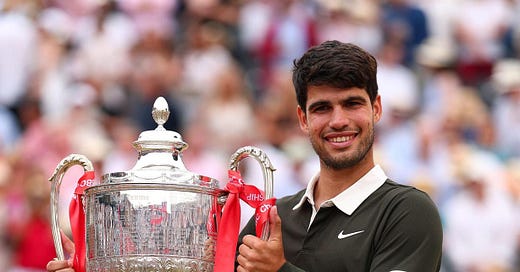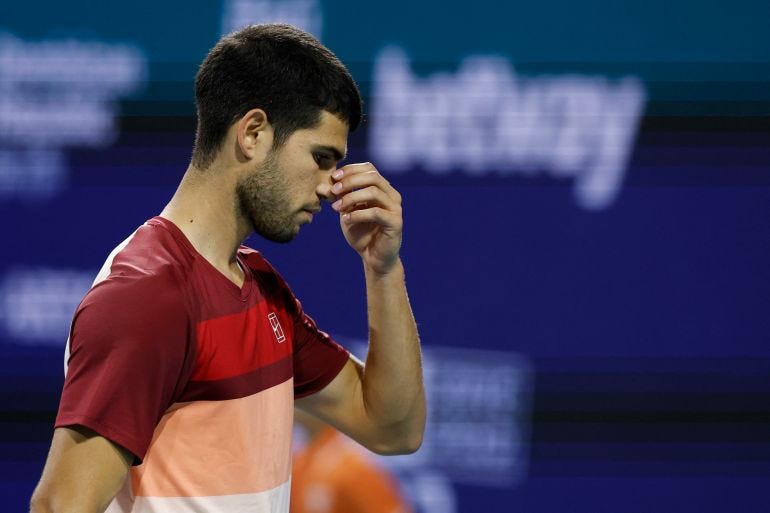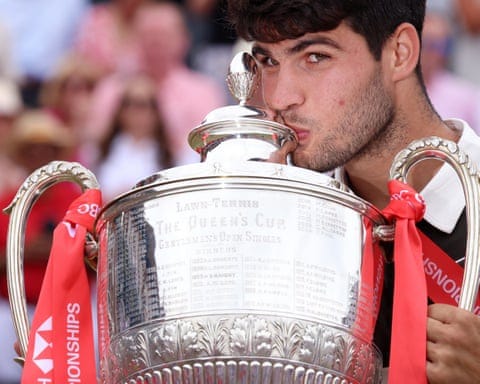Exactly three months ago to the day, Carlos crashed out of Miami against Goffin. It was a bad loss, in a tournament he had previously won. And it came right after what was probably his worst defeat of the year, against Draper at Indian Wells, a tournament both Carlos and his fans circle as a must-win at the start of every season.
There were all kinds of takes after that match, but what I kept thinking about most was the lack of improvement or even progression in his game since the start of 2024. Every individual aspect felt like it was plateauing, if not regressing. You could see the confidence dip too: more visible frustration, fewer smiles, more yelling at his box. The little things that stand out with a player who wears his emotions so openly—it all just felt uncharacteristic.
And now, three months later, it all feels like a fever dream.
Carlos has won all three big titles he’s played since then. He just defended his Queen’s title, and now holds more grass titles (4) than grass-court losses (3). He’s opened up a 2,200-point lead in the race to Turin, is the clear favorite to three-peat at Wimbledon, and is right back in the thick of the Year-End No.1 conversation.
So, what changed?
I’ll save most of that for a full natural surface swing review after Wimbledon. But for now, let’s zoom in on Queen’s.
FREE POINTS
We all know Carlos has made several changes to his serve over the last two years—all in an effort to reduce the lag he once had in his motion and make the entire routine more mechanically fluid. The goal was to maximize the kinetic chain and eliminate unnecessary pauses.
The results, throughout this season, haven’t consistently been there.
Every numerical metric is down this year compared to 2024, except for the ace rate, which is up by about 5%. But that doesn’t mean much in isolation, as its counterpart, the double fault rate, has jumped by 40% over the last season. So, while it was fair to say that the revamped serve may benefit him in the long term, even if it is just by reducing strain on his body, the tangible results this season hadn’t really materialized.
Until this week.
This tournament marked a personal best for him in ace rate, hold percentage, and first-serve points won. The higher-than-usual double fault rate also indicates that he was more aggressive on second serves, going for both pace and placement, and accepting the occasional double fault in exchange for greater reward. I don’t have the exact number, but I’m confident he hit at least five aces on second serves this tournament, a remarkable display of risk-reward management.
So, how did his serve make such a significant leap? Well, I believe it has been steadily improving throughout the season. And now, it finally got a taste of grass—a surface where, even historically, Alcaraz’s serve has tended to perform better due to:
The variation package on his serve plays a big role. The sliders out wide, which are already his go-to due to the lack of a consistent T-serve, become even more effective on grass thanks to the lower bounce and skiddy nature of the surface—traits that aren't available to him on hard courts.
Alcaraz is still more of a pace server than a spot server. On hard courts, that high pace can often land right in the strike zone of elite returners. But on grass, the added zip and pop on the ball tends to make it skid through more effectively, often rushing even the best returners.
So, do I expect him to post the same serving numbers at Wimbledon? That would take a Herculean effort, and most likely, no. But is the serve ready in time for a three-peat attempt? Absolutely, it is.
NUCLEAR
Since the Munar match, Carlos has delivered three consecutive A-grade forehand performances. That’s not something we’re used to seeing—his forehand potency often fluctuates within sets, let alone across entire matches.
His Tennis Insights forehand rating for the Rinderknech match? A staggering 9.9. Yes, you read that right. The first set against RBA clocked in at 9.6. That’s full-on nuclear mode. Across those two matches, he racked up 31 forehand winners to just 13 unforced errors—a phenomenal 2.4 ratio.
And the forehand showed up in the final too, especially when it mattered most, down the line, under pressure. I’ve always believed that while a player’s weaknesses set the floor, it’s the big weapons—the Nadal forehand, the Federer serve—that define the ceiling.
This week, a player with many weapons had his biggest one show up in spectacular fashion.
NEED FOR SPEED
Alcaraz’s speed on grass — even after multiple lower-body injury scares — is ridiculous. To maintain such a high steal percentage on a court that’s most likely faster than what he’ll get for most of Wimbledon is both a great sign for him and a warning for his opponents.
This is the part of his game that remains true on every surface, and although the balance and efficiency in steps can surely be improved, when you have speed like this, and knees still going, one tends to worry less, if at all. On a surface that is purely winner-centric, this continuous retrieval of balls that should be point-enders is one of the ultimate equalizers to have.
LOOKING AHEAD
The backhand looked better here than it did at the start of the clay season, with the blending of his two swing paths creating a modified, more compact but still bent-arm extension — an ideal shield when needed. I’d like to see him slice more at Wimbledon, as that part of his game feels criminally underused considering how effective his slice can be, especially against opponents like Djokovic and Sinner.
The return will need to improve — the reps here will surely help as he looks to maintain one of his most distinct advantages on grass, the first serve return, while simultaneously improving one of the more pedestrian aspects of his game on this surface: the second serve return.
Overall, you can’t really ask for much more when the player wins the greatest Slam match of the decade, goes to Ibiza, stays disciplined enough to not show up drunk three days later in London (unlike last year), wins a close marathon match, flexes his forehand and serving muscles, and takes home the title. Now, let’s see how he copes with the pressure of being a clear-cut favourite and the challenge of a three-peat at Wimbledon. Vamos!









